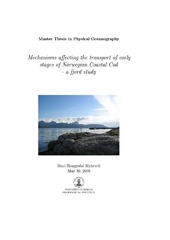| dc.contributor.author | Myksvoll, Mari Skuggedal | eng |
| dc.date.accessioned | 2013-09-18T11:28:30Z | |
| dc.date.available | 2013-09-18T11:28:30Z | |
| dc.date.issued | 2008-05-30 | eng |
| dc.date.submitted | 2008-05-30 | eng |
| dc.identifier.uri | https://hdl.handle.net/1956/7216 | |
| dc.description.abstract | The fjord system of Sørfolda and Nordfolda situated in northern Norway is used in a model study. Particularly to explore the mechanisms causing separation and mixing of eggs from Arcto-Norwegian Cod (ANC) and Norwegian Coastal Cod (CC). The Regional Ocean Modeling System (ROMS) simulates the circulation in the fjord, characterized by the estuarine circulation. The major forcing to the fjord system is the fresh water discharge, with its seasonal and interannual variations. Two extreme years with respect to runoff were chosen to study; 1960 representing a cold and dry year, and 1989 representing a warm and wet year. The estuarine circulation was established during both years, with 1989 generally having a fresher surface layer. The onset of melting season was approximately one month earlier in 1989 compared to 1960. A particle tracking model was used to transport CC eggs in the fjord system. Particles drifting at fixed depths showed especially larger spread at 1 m depth during 1989 than 1960. Most particles lower in the water column stayed within the fjord system. The particles was added a dynamical vertical distribution, as a function of buoyancy and mixing. A fresher surface layer in April 1989 compared to 1960 caused a larger fraction of the eggs to be heavier than the brackish layer. When the eggs are situated lower in the water column, the possibility of being transported away is much smaller and the degree of retention is larger. Considering the last part of the spawning period a stronger separation between ANC and CC is observed in 1989 compared to 1960. The results indicate that CC have adapted the buoyancy of eggs to increase retention of eggs inside the fjord system. From the results it is concluded that CC are self-recruiting and the separation between ANC and CC eggs are strong. Future climate change might enhance the separation between the two populations. | en_US |
| dc.format.extent | 6828803 bytes | eng |
| dc.format.mimetype | application/pdf | eng |
| dc.language.iso | eng | eng |
| dc.publisher | The University of Bergen | en_US |
| dc.subject | Fjord modeling | eng |
| dc.subject | Vertical distribution of eggs | eng |
| dc.subject | Norwegian Coastal Cod | eng |
| dc.title | Mechanisms affecting the transport of early stages of Norwegian Coastal Cod - a fjord study | en_US |
| dc.type | Master thesis | |
| dc.rights.holder | Copyright the author. All rights reserved | en_US |
| dc.description.degree | Master i Geofysikk - Fysisk oseanografi | en_US |
| dc.description.localcode | MAMN-GFFYS | |
| dc.description.localcode | GEOFFYS | |
| dc.subject.nus | 759906 | eng |
| fs.subjectcode | GEOFFYS | |
